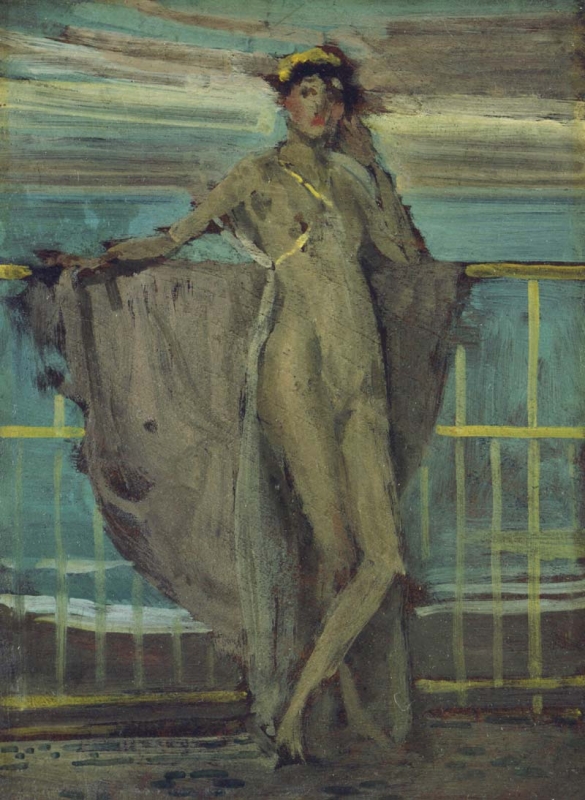Home > Catalogue > Browse > Sketch for 'Annabel Lee' << >>
Composition
In colour and composition this young woman on a balcony resembles Annabel Lee [YMSM 079], although the colour of the dress in Annabel Lee inclines more to shades of green and blue. The woman in the 'sketch' has a yellow ribbon in her hair, and her cloak is tinged with lilac.
Whistler painted a model in a similar pose, standing on a plaited rug by a balcony, in a painting exhibited in 1879, Harmony in Blue and Gold [YMSM 197], which was perhaps reworked and exhibited again in 1886. It has disappeared but is recorded in a drawing, Sketch of 'Harmony in Blue and Gold' [M.1095], where the figure stands in a similar pose to the Sketch for 'Annabel Lee', with the addition of a parasol.
Technique
It is painted on an oak or mahogany board, 5-6 mm thick, with beveled edges on the verso. It may be a single section of wood, radially cut; the grain of the wood is prominent, running diagonally left to right. The wood shows through in places, particularly around the figure. 1 It has a very thin absorbent priming of lead white and chalk. The thin paint, which resembles Whistler’s thinned ‘sauce’ rather than megilp, suggests a late rather than early date; it has sunk into the absorbent priming. The yellow paint for the balcony rails includes zinc yellow and the flesh paint probably includes natural red ochre; Prussian blue is probably present. 2 The robe is of flesh colour and dull, light pink, with a yellow ribbon; the sky, lemon, pink and turquoise. The brushstrokes run from left to right across the background, and stop abruptly at the right edge.
Whistler used very small round brushes (1-2 mm). The figure was painted first, then the fabric over the rail, the sky and water, the verticals, and finally the horizontals of the railing, with the paint drying fast. The head and hands are painted rather untidily. The background sea and sky were painted together, wet-in-wet, and the vertical railings were added while the water was till wet; however, it was drying fast since the horizontal rails dragged the paint of the water less. The sky was painted round the figure, the horizontal brush strokes creating an uneven outline around the girl's head and arms.
Her limbs are very thin and angular. There are signs of changes around her head, which suggest that either her robe originally billowed out around her head, or that she was shown undressing.
Conservation History
The panel is in fair condition (some fine abrasions may date from the artist's working process). 3
Frame
It is in a Grau style frame, date unknown , 54.0 x 46.0 x 7.0 cm.
Notes:
1: Conservation report by Clare Meredith, 29 May 2001, Hunterian files; visual examination by Robert Anderson, The Hunterian, and Prof. Joyce H. Townsend, Tate Britain, 2017.
2: Technical examination at Natural History Museum, London, and report by Prof. Joyce H. Townsend, July 2017.
3: Meredith, 29 May 2001, op. cit.
Last updated: 20th October 2020 by Margaret








